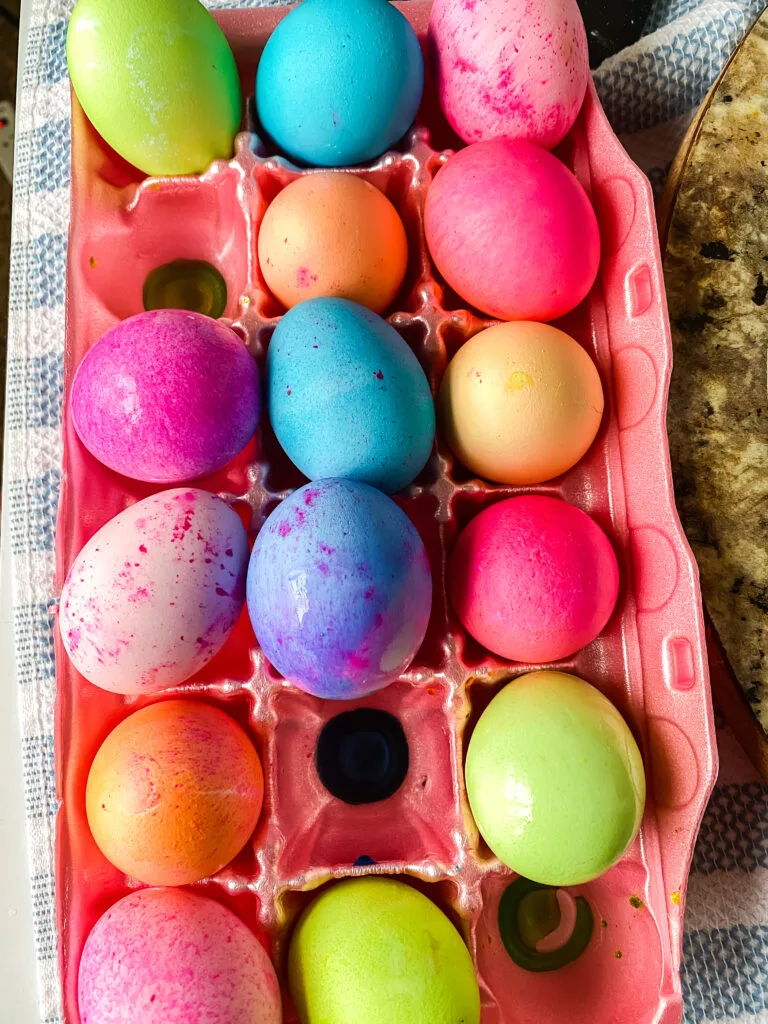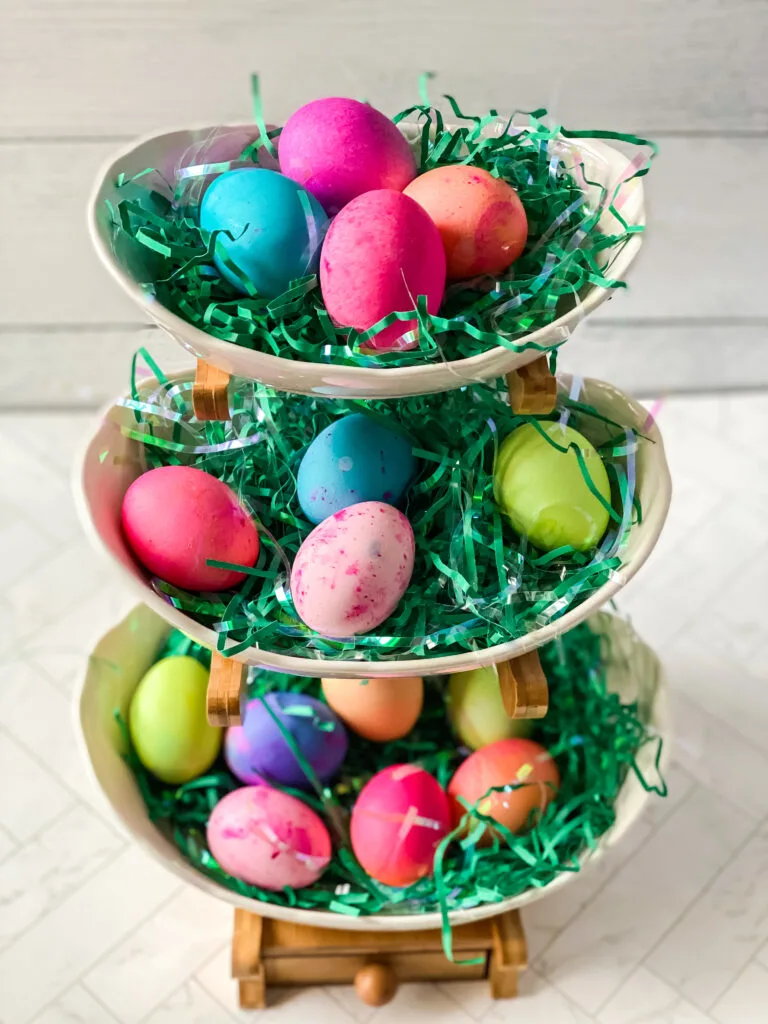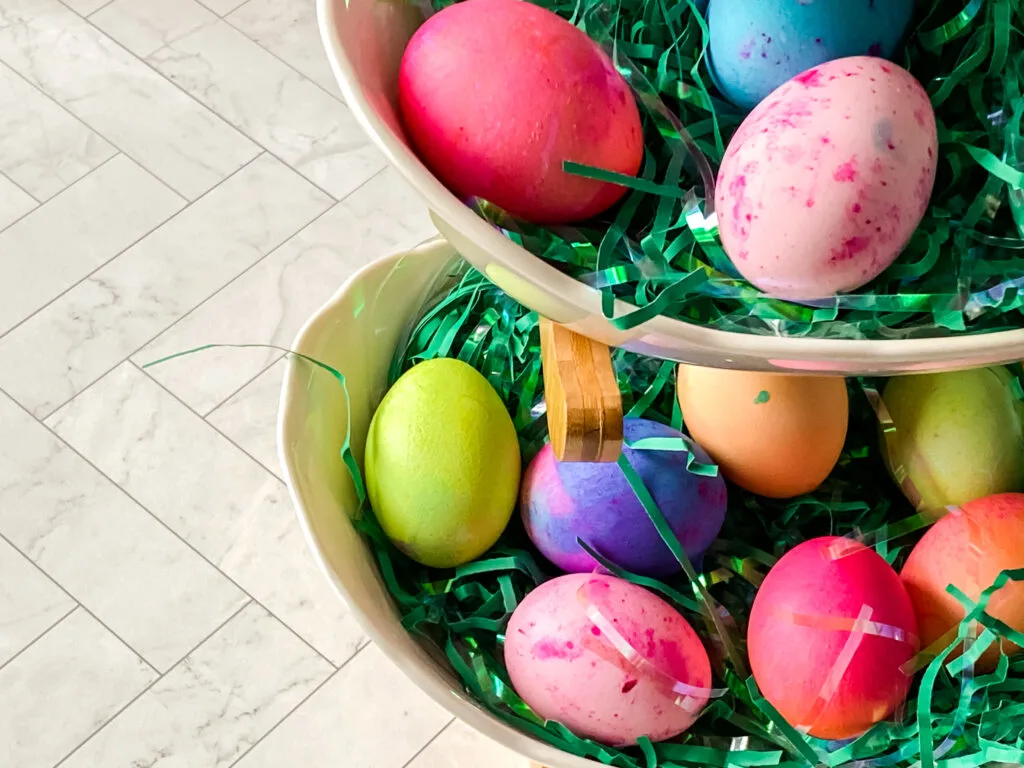Discover how to dye eggs with food coloring for vibrant and colorful Easter creations! Learn easy techniques and tips to make your egg decorating a fun and festive experience.

Get ready to add a splash of color to your Easter celebrations! Dyeing eggs with food coloring is a classic and creative tradition that’s perfect for the whole family to enjoy.
This year, try using food coloring to dye your eggs with this easy tutorial. With food coloring, you can create some really vibrant and beautiful eggs that will look great in your Easter basket or for your Easter egg hunt.
Dying eggs with food coloring is an easy and affordable way to decorate your eggs. The whole family can get involved in Easter traditions like dying Easter eggs.
You can have bright Easter eggs every color of the rainbow using a dye bath.
Read on for the easy steps to dye Easter eggs with food coloring.

How to Dye Eggs with Food Coloring
Dyeing eggs with food coloring is a simple and fun process that allows you to create beautiful, vibrant eggs in a variety of colors. Here’s a step-by-step guide on how to dye eggs using food coloring:
Supplies Needed
- Table Covering
- Boiling Water
- White Vinegar
- Food Coloring (liquid dye or gel food coloring) or natural dyes
- Plastic Cups or Bowls
- White Eggs – hard boiled and cooled to room temperature
- Paper Towel
- Tongs, Egg Dippers or Slotted spoon

Instructions
In each cup or bowl, mix water, food coloring, and a splash of vinegar. The vinegar helps the dye adhere to the eggshell and creates more vibrant colors. Fill cups, bowls or containers with enough water to cover the egg, 1 teaspoon of vinegar and a few drops of food coloring.

Place eggs on a slotted or regular spoon and dunk into the vinegar mixture, ensuring they are fully submerged, turning occasionally so both sides are colored.


Let the eggs sit in the dye for several minutes, depending on how vibrant you want the colors to be.
Keep the eggs in the cups of dye up to 5 mins or longer for darker colors. The desired color of the egg depends on the amount of food coloring and how long it stays in the colored water.


Experiment with mixing different food coloring shades to create custom colors. You can also try layering colors or using wax crayons to create designs before dyeing.
Once you’ve achieved your desired colors, remove the eggs from the dye and place them on a paper towel to dry. Once dry, display your beautifully dyed eggs in a decorative basket or centerpiece.
Tips For Dying Easter Eggs with Food Coloring
- The key to properly dyed eggs is taking your time throughout this process.
- For best results, hard boil the eggs earlier in the day or the night before.
- Each of the bowls of dye will need enough boiling water to cover the egg completely once submerged.
- Using liquid food coloring will require up to 20 drops of food dye, using gel colors requires 1-3 drops depending on the intendent depth of color
- If you don’t want to use food coloring, natural ingredients such as fruits and vegetables are an easy way to dye eggs. Examples of colored eggs using Natural Easter Egg Dyes include red cabbage, purple cabbage, blueberries, lime juice or lemon juice.
- Of course, if you are planning on eating these eggs, be sure to keep them in the refrigerator. We often make deviled eggs for our Easter gathering!

Creative Ways to Decorate Easter Eggs
- Glitter Eggs or using shaving cream are ideas for a fun simple craft at Easter time.
- Use a white crayon to draw on the eggs or wrap the egg in rubber bands.
- Use Kool Aid to Dye Easter Eggs
- Or use the old-fashioned way of egg dye kits.

FAQs
How do you get dye to stick to eggs?
To ensure dye sticks effectively to eggs, start by cleaning them thoroughly with warm, soapy water to remove any dirt or residue. Add white vinegar to your dye mixture to enhance adhesion, as the acidity helps the dye penetrate the eggshell. Submerge the eggs completely in the dye, allowing them to soak for a few minutes to achieve vibrant colors. Pat the eggs dry gently after dyeing to prevent smudging or removing the dye. Following these steps ensures beautifully colored and vibrant Easter eggs.
Can I dye eggs with natural food coloring?
Yes, you can use natural ingredients like beet juice, turmeric, or spinach to create natural dyes for Easter eggs.
How long do you leave eggs in food coloring to dye?
The longer you leave the eggs in the dye, the more vibrant the colors will be. Start with a few minutes and adjust the time based on the intensity of color you desire.
Can I eat eggs dyed with food coloring?
Yes, eggs dyed with food coloring are safe to eat as long as they have been properly refrigerated and not left out at room temperature for an extended period.
How do you dye brown eggs with food coloring?
Dyeing brown eggs with food coloring requires thorough cleaning and the use of a dye mixture containing food coloring, water, and white vinegar. The vinegar aids in adhering the dye to the eggshells and creating vibrant colors. Experimentation with dye concentration and soaking times is key to achieving desired results on brown eggshells.

*Contains affiliate links

How to Dye Easter Eggs With Food Coloring
Materials
- Table Covering
- Boiling Water
- White Vinegar
- Food Coloring (liquid or gel)
- Plastic Cups or Bowls
- Hard Boiled Eggs that have been Cooled
- Paper Towels
- Tongs, Egg Dippers or Slotted spoon
Instructions
- Fill cups, bowls or containers with the enough water to cover the egg, 1 teaspoon of white vinegar and food coloring.
- Place the egg on a slotted or regular spoon and dunk into the mixture, turning occasionally so both sides are colored.
- Keep in the liquid up to 5 mins or longer for darker colors.
- Carefully remove the egg and set it aside to dry.
Notes
- The key to properly dyed eggs is taking your time throughout this process.
- Cover your work surface with towels or newspapers to protect them being stained.
- Each color will need enough boiling water to cover the egg completely once submerged.
- Using liquid colors will require up to 20 drops, using gel colors requires 1-3 drops depending on depth of color.
Recommended Products
As an Amazon Associate and member of other affiliate programs, I earn from qualifying purchases.
-
 Wide Mouth Glass Mason Jars
Wide Mouth Glass Mason Jars -
 Spice Supreme Assorted Food Colors Red Blue Green Yellow - 4 Color Cake Liquid Variety Kit for Baking , Decorating ,Fondant , Cooking, and Slime Making - .30 fl. oz.Bottles
Spice Supreme Assorted Food Colors Red Blue Green Yellow - 4 Color Cake Liquid Variety Kit for Baking , Decorating ,Fondant , Cooking, and Slime Making - .30 fl. oz.Bottles -
 12 Color Cake Food Coloring Set, Nomeca Food Grade Vibrant Food Color Liquid Dye Tasteless for Baking, Icing, Decorating, Fondant, Cooking, Slime Making DIY Supplies Kit - .35 Fl. Oz (10 ml) Bottles
12 Color Cake Food Coloring Set, Nomeca Food Grade Vibrant Food Color Liquid Dye Tasteless for Baking, Icing, Decorating, Fondant, Cooking, Slime Making DIY Supplies Kit - .35 Fl. Oz (10 ml) Bottles
